The Earth is filled with mysteries and wonders. All around the globe we are graced with marvels of beauty; stunning landscapes that take our breath away, seemingly boundless oceans, and beyond.
Tucked into the vast ecosystems of our planet are some of the greatest, weirdest, and rarest tasty treasures.
In this article, we’re going to highlight the weirdest and rarest fruits you’ll find on this planet. While these fruits may not be rare or odd in their home country, to us Westerners they are exotic on an almost alien level.
Let’s take a moment and think outside of the common apple, the juicy peach, and the bright red strawberry. These are the fruits we know and love, but for the purpose of this article, we’re going to move those widely known fruits to the side. Now that our palette is ready for something fresh and new, let’s dive into 15 of the rarest and weirdest exotic fruits on the planet!
1. Black Sapote
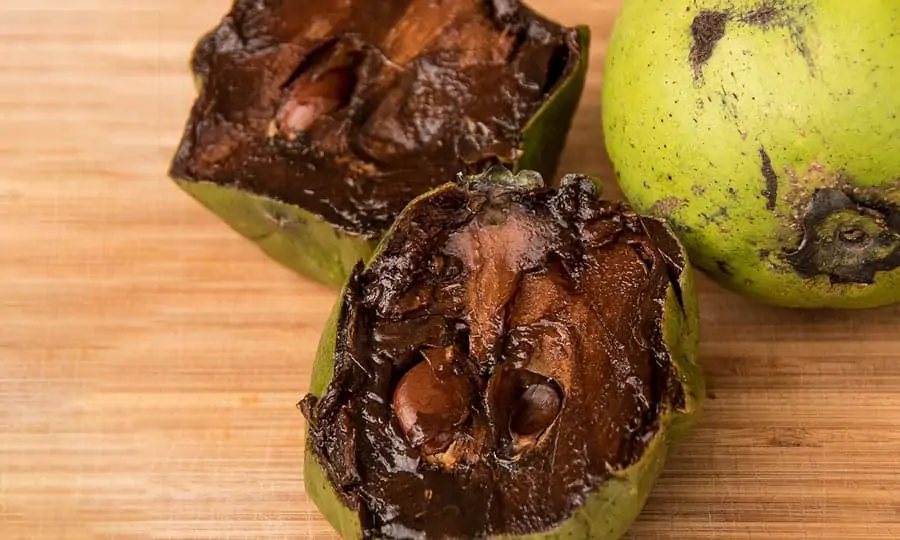
When you think of a deliciously ripe fruit, the color black usually doesn’t come to mind, nor does it sound very appetizing. But, the black sapote fruit may be an exception to this unwritten rule.
Native to the tropics of Mexico, Central America, and Columbia the black sapote fruit is a species of persimmon. It looks similar in size and shape to the common persimmon we Westerners are more familiar with.
The skin is green, turning to a yellow-green color when ripe. The pulp inside the inedible skin is white when unripe, turning to a dark brown/black color when fully ripe.
While the dark color of the ripe fruit is certainly enough to make it unique, the black sapote fruit truly stands out in its taste and texture. This wondrous fruit is said to have the consistency and taste of none other than chocolate pudding. Talk about a hidden treasure of the Earth!
Purchase Black Sapote At MiamiFruit.org
2. Gac Fruit
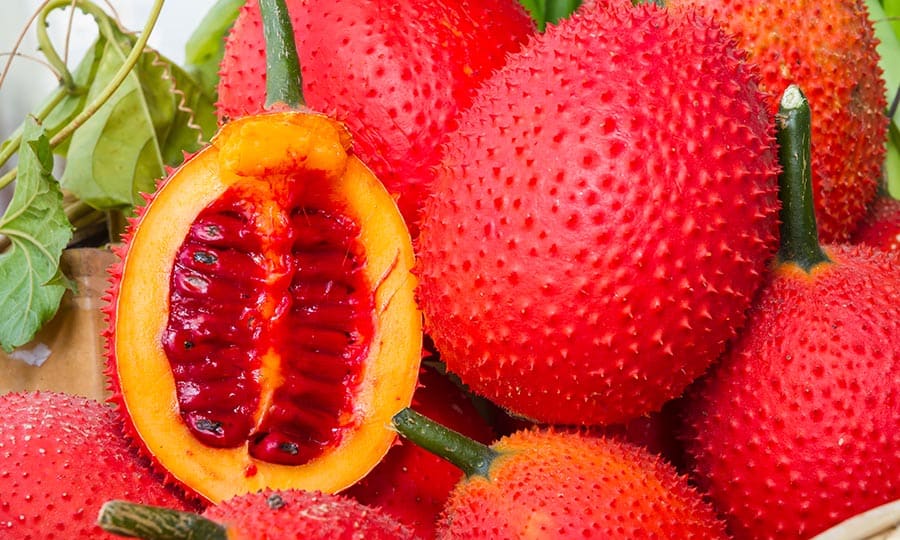
The gac fruit is one of those exotic fruits that is incredibly visually pleasing to look at. Its spiny orange rind and deep magenta red pulp gives it an ethereal, "out of this world" look.
This small, melon-like fruit is native to southeast Asia and it is especially common in Vietnam. The oily red sacs found in the inedible spongy skin are said to have a moderately sweet taste that is similar to a cucumber, melon, and carrot.
The gac fruit is not only exotic in its appearance, but this fruit is also quite rare. With a relatively short harvest season in the fall, gac is traditionally used in seasonal festivities and ceremonies in Vietnam.
Purchase Gac Fruit At ExoticFruitMarket.net
3. Kiwano Melon
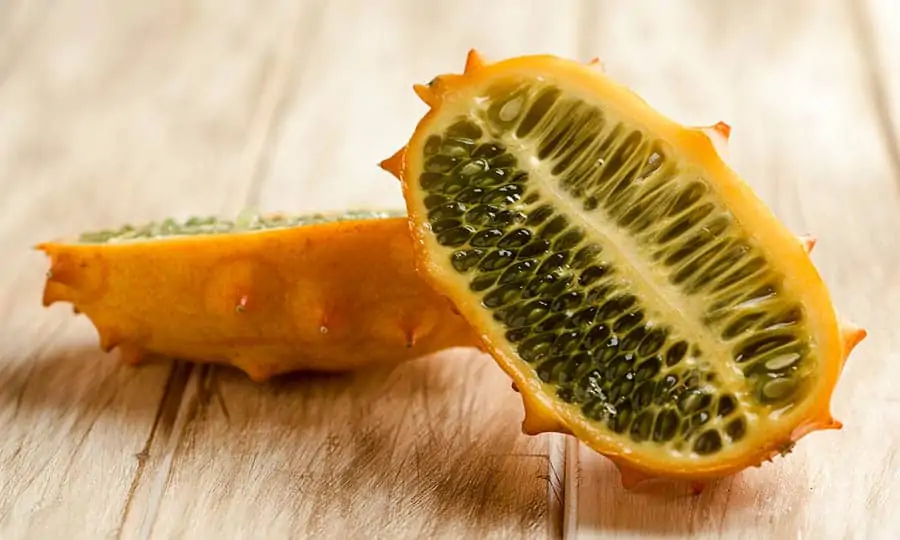
The kiwano melon is another exotic fruit that looks like it could be a prop on Star Trek (no surprised, it was). The orange, speckled color rind has these fantastical little horns all over it, which points to its other common name: "the horned melon".
The inner pulp is lime green and slimy when ripe. Its taste is said to resemble that of a banana the riper it is with hints of cucumber, kiwifruit, and zucchini. With such a unique and delicious flavor profile, the kiwano melon is quite popular in its native region of Africa, New Zealand, and Australia.
The kiwano melon is also packed with vitamins, antioxidants, and other benefits.
Purchase Kiwano Melon At Melissas.com
4. Lychee
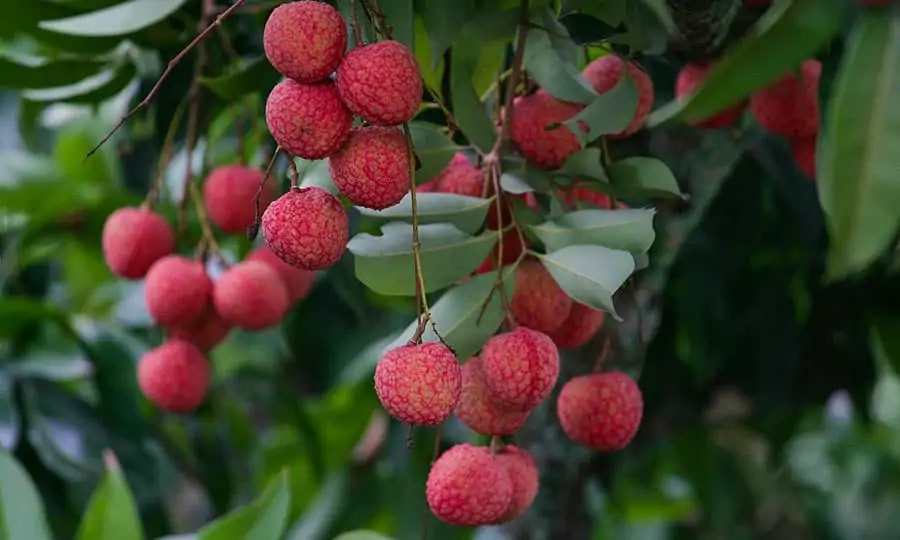
Imagine you’ve taken a trip to China or somewhere in southeast Asia. You’re out for a stroll when you look up to see a tree densely filled with bright red, berry-like fruits. Meet the lychee (also called "litchi"); a small round fruit with bumpy skin and bright white inner flesh.
This tropical fruit is seen as a treasure in China, and it is prized for its floral scent and sweet taste. The rind is thin and easy to peel, which adds more to its appeal as there is plenty of flesh to eat.
While wonderful to eat when fully ripe, this fruit has proven to be toxic if consumed unripe. You’ll know it’s ready to eat if it is vibrant in color and the skin is soft when pressed.
Purchase Lychee At YPFarms.com
5. Mangosteen
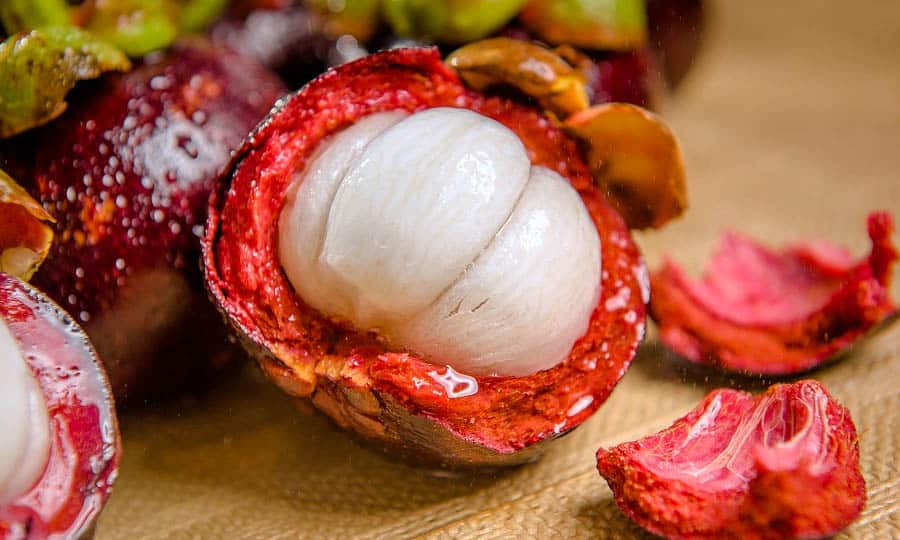
Mangosteen is one of the few fruits on this list that was once banned in the United States. Why? The US government was concerned that importing mangosteen would bring with it Asian fruit flies, a destructive agricultural pest. Thankfully for your tastebuds, the ban was lifted in 2007 but the mangosteen fruit must go through proper irradiation first.
The mangosteen is difficult to find in the US due to its finicky climate needs and easy bruising, but it is claimed to be one of the most delicious fruits you can eat. Its history is even more intriguing, as it’s said that Queen Victoria herself coveted this little fruit so much that she would grant knighthood to anyone who brought her one.
If you do happen to get your hands on one, you’ll find a dark purple, citrus-sized fruit with a few white flesh slices inside. Each fruit doesn’t offer much edible flesh inside, which adds more to the difficulty of having it transported to the US. The mangosteen’s elusive ways make it one of the rarest fruits you can find.
Purchase Mangosteen At MiamiFruitBox.org
6. Buddha’s Hand
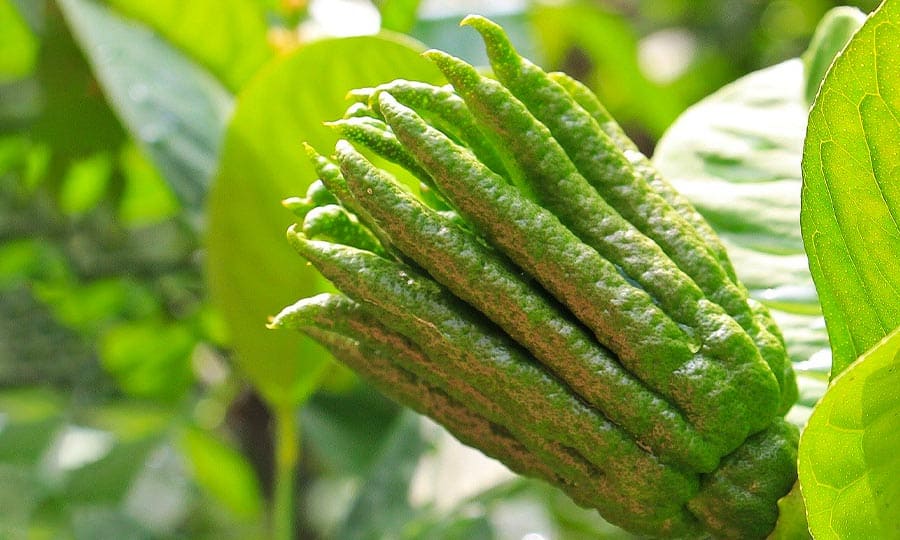
It's possible this might be one of the most peculiar looking fruits you've ever seen. Buddha’s hand is a visually breathtaking fruit that looks like a deformed lemon with tentacles growing off of it. Thankfully, the smell and taste aren’t as off-putting as its appearance, as it is said to have a lovely, lavender-like scent.
Because there isn’t as much flesh compared to the rind, the smell and unique shape of buddha’s hand is what brought it to popularity. It is used in celebrations in China and Japan, especially on the new year, as a symbol of longevity, happiness, and good fortune.
While rare, flamboyant buddha’s hand is cropping up more and more in specialty stores and Asian markets. If you find it, try adding its wonderfully aromatic rind to your next salad or savory dishes such as pasta. Or, you can even candy it (like in this recipe) for a sweet treat on the go.
Purchase Buddha’s Hand At FrogHollow.com
7. Jabuticaba
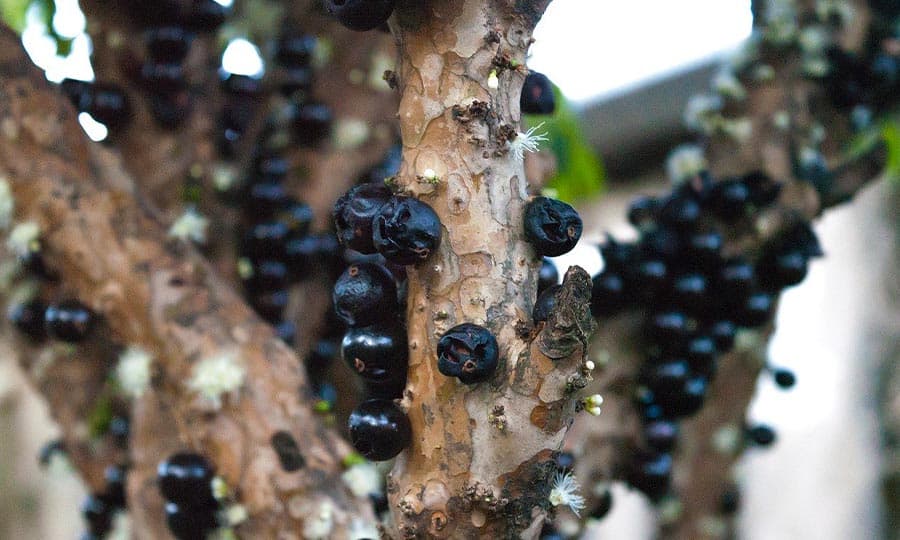
Appearing more like fungi than fruit, jabuticaba (also called "jaboticaba") berries have quite an interesting growth pattern. Instead of growing off a branch amongst the leaves like most fruits, jabuticaba grows directly off of the tree trunk and branches. Based off of the picture above, you can tell it's a strange sight to see them growing in the wild.
These dark purple berries resemble a large grape and are extremely rare to find outside of Brazil. Difficult to cultivate with a very short shelf life, jabuticaba berries are unable to be transported and must be sought after in their native lands.
If you happen to travel to Brazil, you should definitely give these exotic berries a try. It may be your only chance to do so! Not only are they sweet and tart, but they are also packed with antioxidants (polyphenols) and more. Jabuticaba berries are also said to contain anti-inflammatory properties. These unique qualities lead it to be highly popular in Brazil as it borders the line between medicine and food.
Purchase Jabuticaba At MiamiFruit.org
8. Dragon Fruit
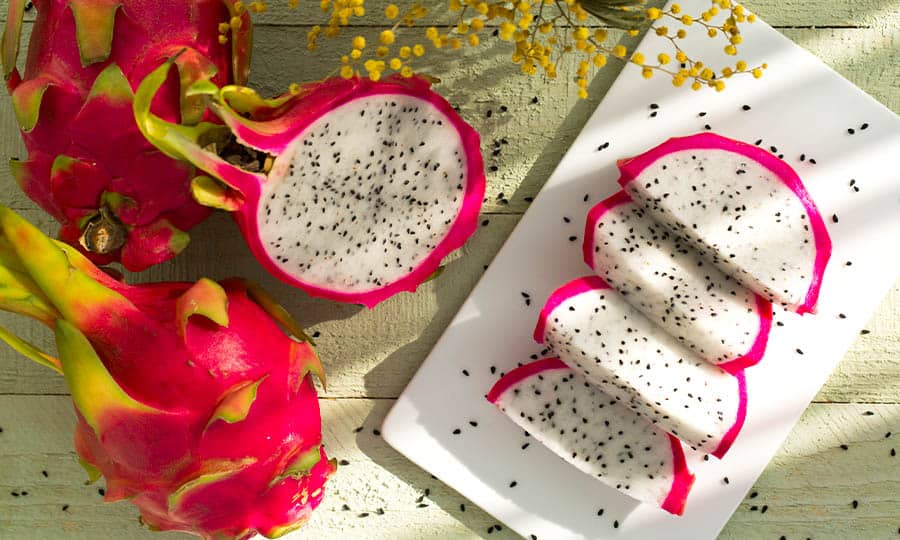
Thanks to Starbucks, almost everyone in the US has had least heard of this popular fruit. However, those who have loved dragon fruit for generations are probably scoffing or rolling their eyes at that statement.
Although dragon fruit (also known as pitaya) isn’t too rare these days, this list wouldn’t be complete without this weird and otherworldly fruit. With lovely pink-red skin and bright green scales, this fruit has caught the attention of many from all over the globe. Native to Mexico and Central America, dragon fruit is now widely cultivated and can be found in most specialty grocery stores. It's also popped up as a popular ingredient in many Daily Harvest smoothies.
Not only does dragon fruit skin make it look unique, but also its striking white pulp with black seeds makes this fruit wonderfully exotic. What's even more intriguing about this fruit is that dragon fruit grows on a cactus that only flowers at night. Talk about otherworldly!
Purchase Dragon Fruit On Amazon.com
9. Rambutan
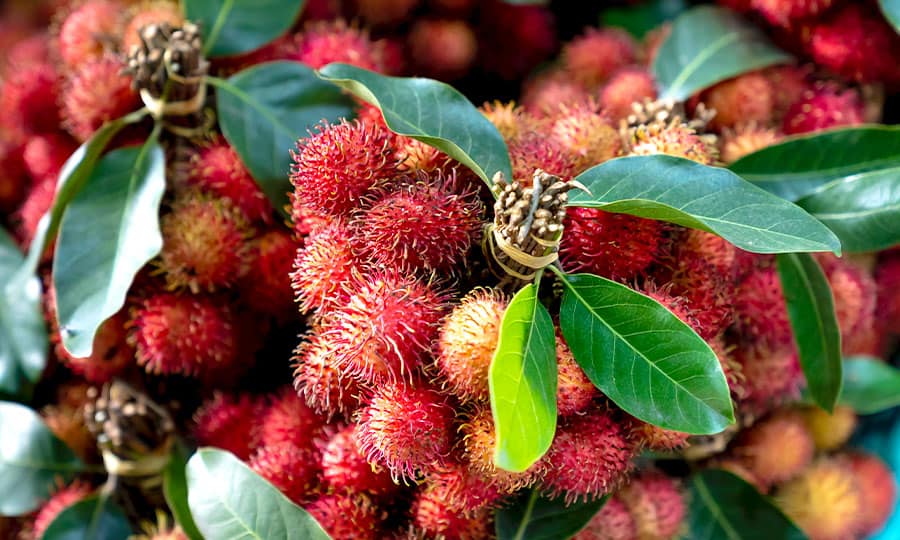
Rambutan looks more like a sea urchin you'd find in the depths of the ocean than a traditional fruit. All those little vibrant green hairs dancing wildly about make these round fruits marvelously weird.
Peeling back the thin red rind reveals a smooth white flesh within. The fruit is said to be sweet and tastes similar to lychee, which would make its flavor more floral. These happy wonders of the world are most often eaten fresh and as a snack due to how easy it is to peel them.
While rarer in the US, the rambutan is a common and popular fruit throughout Asia and Australia. Because of its growing popularity in the states, you can now find these fruits in specialty grocery stores or Asian markets.
Purchase Rambutan On ExoticFruitsUSA.com
10. Yangmei
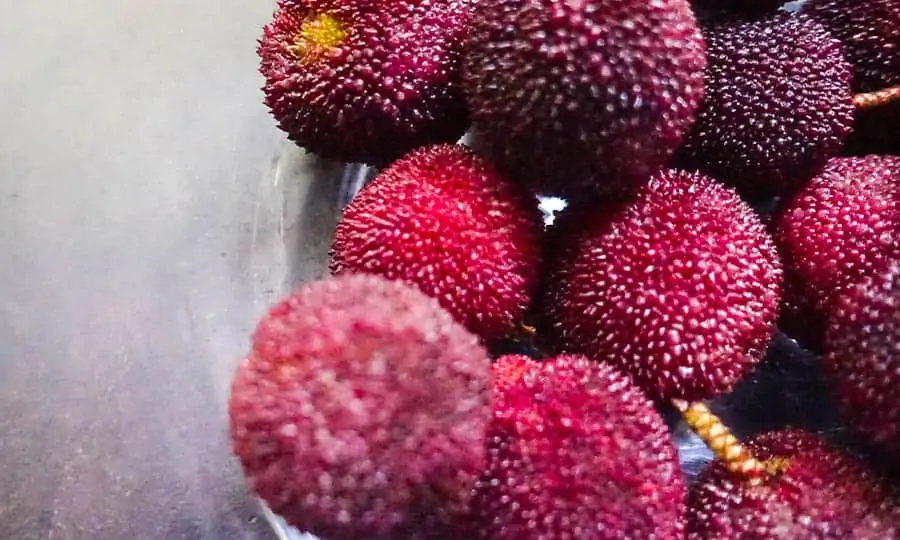
The next exotic fruit to make the list is the unique yangmei berry (also called "myrica rubra"). Yangmei berries are small, about the size of a cherry, with a bumpy dark red exterior. Each bump is an individual stalk of flesh that is attached to the seed at the center of the berry.
These little berries have been a popular fruit throughout China for centuries. What makes yangmei berries so rare to us Westerners is that it is almost impossible to find this fruit outside of Asia. The reason for this is that the space between each individual stalk of flesh is a favored environment for a multitude of pests. In fact, it is common practice to soak the berries in saltwater in order to extract all the hidden creatures within.
While hard to find, this is another fruit that needs to be tried in one’s lifetime. It is said to be delicious and unique; its taste is a mix between a strawberry and raspberry with an herbal twist.
11. Jackfruit
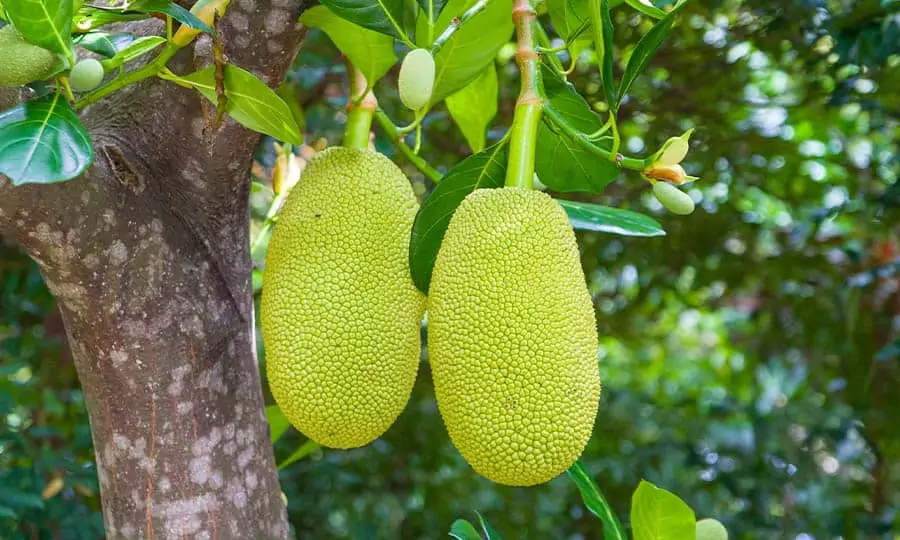
The Jackfruit is perhaps one of the weirdest and most exotic fruits you’ll find. Not only does its large size make it unique (reaching up to 2 feet in length and 40 pounds), but this tropical fruit is also commonly substituted for meat.
Yes, you read that right. Luckily, it doesn’t necessarily taste like meat, but it does have more of a savory-sweet flavor to it than most other fruits on this list.
The texture is stringy and when unripe the flavor is mild and neutral. These qualities are what make it a popular substitute for meat. For this purpose, it is commonly cooked and added to stir-fries, curries, and sandwiches. If that's making you hungry, here's a delicious jackfruit stir-fry recipe you may want to check out.
These green and bumpy fruits are massive and just so happen to be the world’s largest tree-borne fruit. Because of its ability to replace meat, Jackfruit is becoming more and more common throughout the US. You can usually find it cut and peeled in a prepackaged container in a specialty produce store.
Purchase Jackfruit On Amazon.com
12. Hala
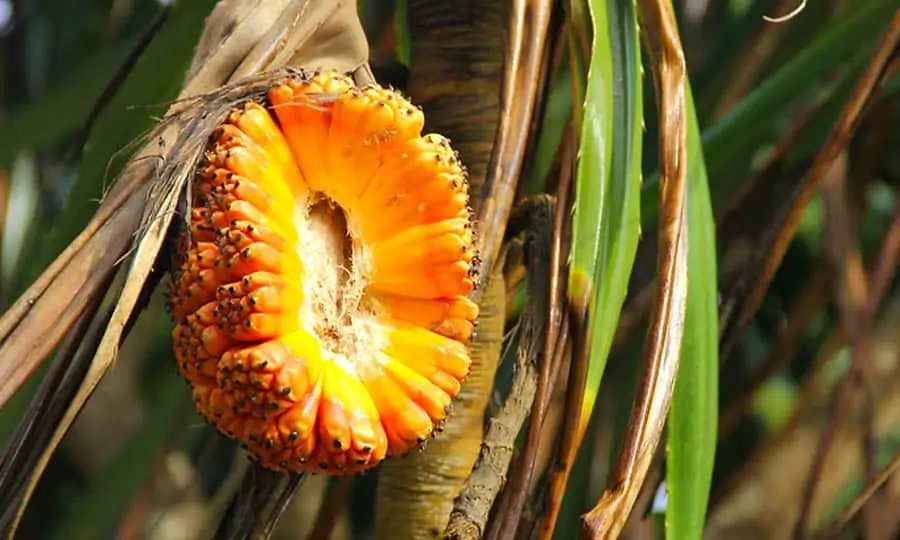
Hala (also known as pandanus tectorius) is an exotic fruit that is a beauty to behold when opened. Although, it's looks are a bit deceiving. While not too visually appealing on the outside, its inner core is fiery red-orange; mimicking a vibrant sunset over the ocean. Some even liken it to the look of an exploding planet.
There are numerous species of hala fruit trees and they are found in the tropics of Southeast Asia, Hawaii, Australia, and the Pacific Islands. These fruits are rare to find because they’re not the easiest to eat. Their hard exterior is made up of individual segments called cones or keys. These segments are what make the interior so beautiful, but they need to be pried out with a hammer. The keys themselves are tough and fibrous, and the pulp found within them needs to be sucked out to be eaten.
Quite the process if you ask me, but they are said to be deliciously sweet and have a banana-like flavor. Hala fruits and leaves are often used in cooking and made into juices, pastes, and various dishes.
13. Salak or Snake Fruit

Just the name of this exotic fruit creates an air of intrigue, for what kind of fruit would be named after a snake? Salak, or snake fruit, is a small oval-shaped fruit that grows in Southeast Asia and is incredibly popular in Indonesia.
It gained its interesting name due to its skin resembling that of a snake. Scaly and red with small spikes, the exterior of the salak isn’t as appealing. But, peel away that rough exterior and you will find a delicious fruit with an addictively sweet flavor profile.
While common throughout Southeast Asia, it is quite rare to find these little marvels in the US. But, if you get your hands on some, it is cautioned to not eat too many at once or your digestion might get a little backed up. It takes longer to digest and thus more acid is released to digest it.
Purchase Salak (Snake Fruit) On MiamiFruit.org
14. Australian Finger Lime
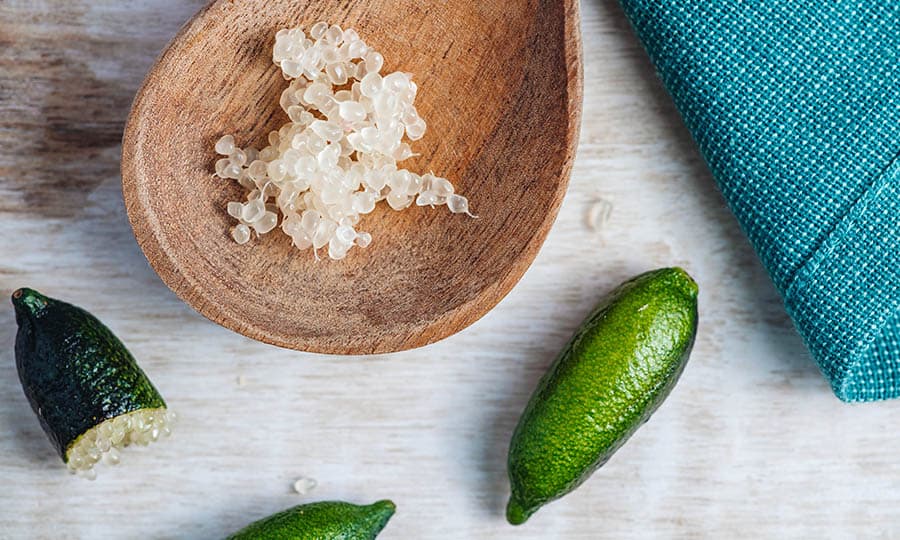
The Australian finger lime is becoming a popular cultivated tree in the US, particularly in Florida. While it may not be as rare as some of the other fruit on this list, based on its looks alone, it certainly makes the cut for being weird and exotic.
The shape of the Australian finger lime is that of a pickle, or a chunky weird-looking finger, which granted it its name. Inside the lime is where the magic happens, for you will find an abundance of juice-filled little beads that resemble caviar.
Because of their bright flavor and the juicy explosion that happens in your mouth when you eat them, Australian finger limes are a favorite among chefs.
Next time you’re in a specialty produce store, see if you can find any of these wonderful treasures. If you do, here are some delectable ways you can use them.
Purchase Australian Finger Lime On Logees.com
15. Monstera Deliciosa
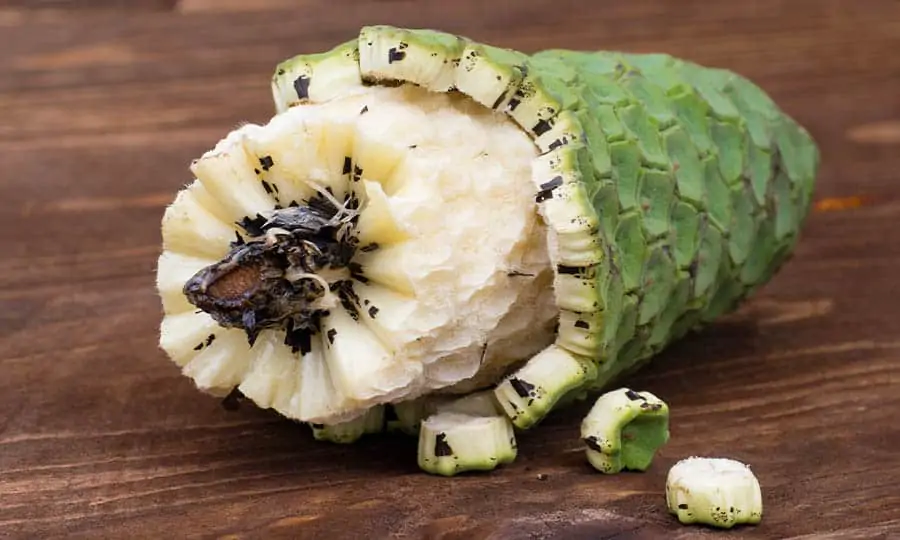
We saved the weirdest and rarest for last. Meet the Monstera deliciosa fruit. This fascinating fruit looks more like unripe corn than tasty fruit. Long with green scales, the delicate and tasty white flesh under the skin is what you’re really after.
What makes this exotic fruit truly unique is the fact that it lets you know when it’s ready to be eaten. This is quite important with the monstera deliciosa fruit because the unripe flesh is slightly toxic. This considerate fruit will reveal its ripe flesh by the green scales peeling away.
Found in the tropics of Mexico and Central America, the exotic monstera deliciosa fruit lives up to its descriptive name. In fact, some even call it the “Fruit Salad Plant” because its sweet flavor is said to be a mixture of every popular fruit (strawberry, banana, mango, pineapple, and more).
Purchase Monstera Deliciosa On MiamiFruit.org
Just A Taste Of The World’s Exotic And Weird Fruits
We’ve covered some of the world’s most exotic and weird fruits, but this list is really just the tip of the iceberg. There's an abundance of strange and delicious fruits out there for you to discover. Sweet morsels hiding in leafy foliage are waiting to be enjoyed all across the globe.
Have you tried any of these weird and exotic fruits? Maybe you’ve tried something delightfully strange that didn’t make the list that you would like to mention. If so, share with us in the comments below. We would love to hear what you’ve discovered!













Awesome post.
We used to have a lychee tree in our backyard and ate so many of them that I can't face them now..
Finger limes are great is Asian or Indian cooking too. We use the a lot.
I want to try all of them!
Do it! 🙂
very perfect article thanks for sharing it with us.
indeed seen some of the rarest fruits here, jabiticaba takes number of 1 on my list, great info here looking forward to seeing more.
wow, on the list i have only tasted jackfruit.
Very educationally!!
Now, I cannot wait to find all these unique fruits!!!
what about the shmungle meister fruit
well i can realky see how wired really they are , but some are actually not wired
That's a nice article!
Thanks!
so bizare, there are some that i thought were not even edible but they are on the list . so amazing how nature works